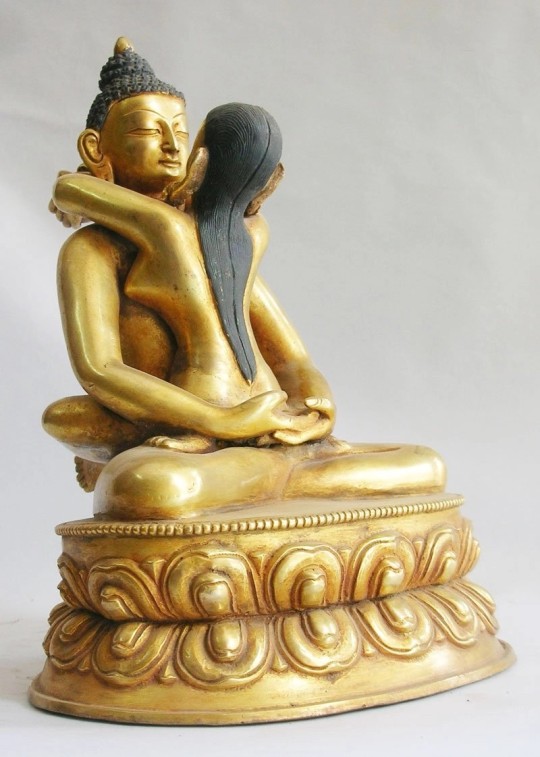#Tantric Buddhism
Text
Tibetan Vajrayana Buddhist Dancing Costumes

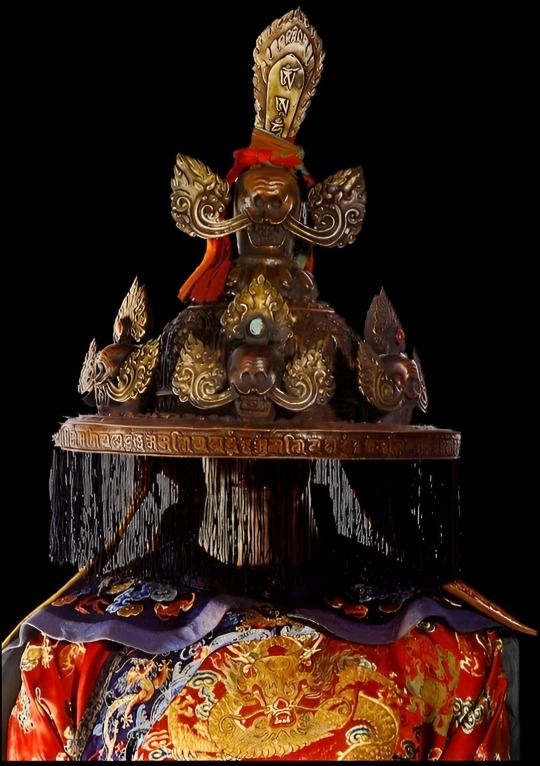


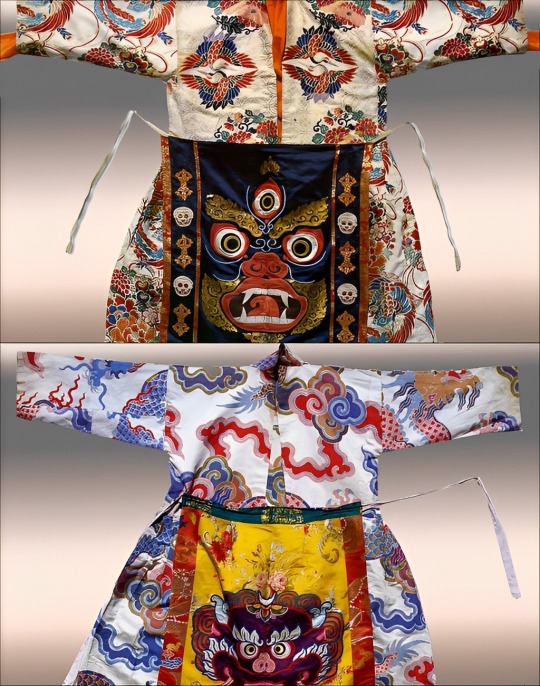
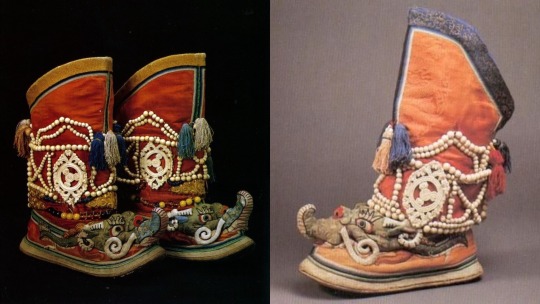


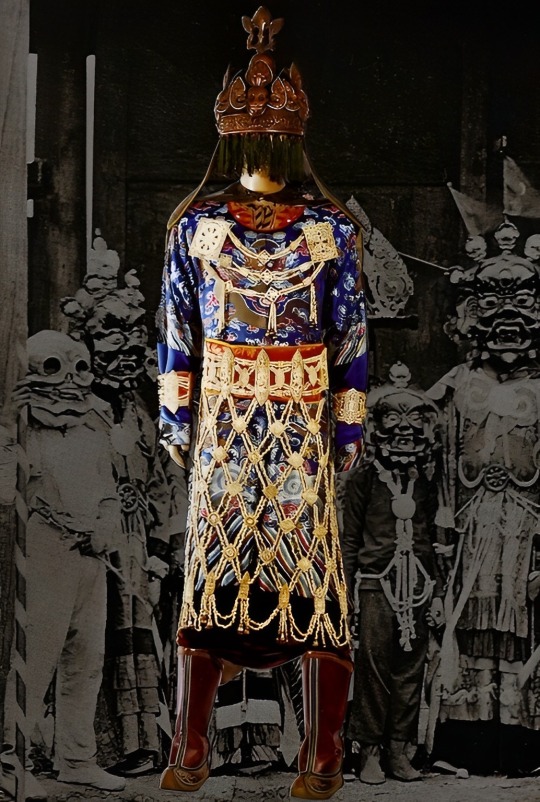

Photos scanned from a 2011 Vajrayana Buddhism Dancing Costume catalogue. © Ais Loupatty & Ton Lankreijer, and Kashba. See rest of catalogue on their website here.
The costumes blend elements from Tibetan, Mongolian, and Nepalese cultures. They may also be used for shamanistic and/or tantric rituals.
#tibet#nepal#mongolia#china#buddhism#vajrayana buddhism#shamanism#tantric buddhism#asia#asian culture#asian art#dancing costume#folk dance#culture
81 notes
·
View notes
Text
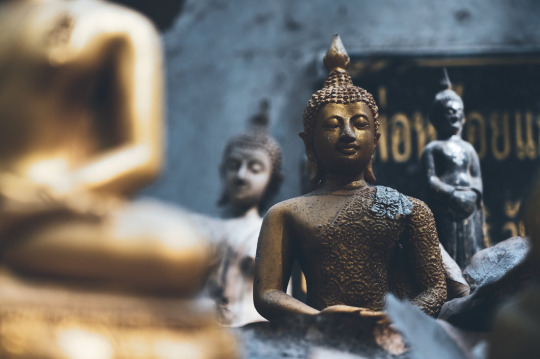
The Voice of the Silence: The Great Perfections
Learn the principles, laws, or qualities of the soul as explained within Christic Buddhism:
1. DANA, the key of charity and love immortal.
2. SHILA, the key of Harmony in word and act, the key that counterbalances the cause and the effect, and leaves no further room for Karmic action.
3. KSHANTI, patience sweet, that nought can ruffle.
4. VIRAG, indifference to pleasure and to pain, illusion conquered, truth alone perceived.
5. VIRYA, the dauntless energy that fights its way to the supernal TRUTH, out of the mire of lies terrestrial.
6. DHYANA, whose golden gate once opened leads the Narjol toward the realm of Sat eternal and its ceaseless contemplation.
7. PRAJNA, the key to which makes of a man a god, creating him a Bodhisattva, son of the Dhyanis. ―The Voice of the Silence
The final lecture of this course explains the Paramitas or Perfections of Mahayana Buddhism in relation to the Christic teachings: the fundamental principles in which a bodhisattva of compassion develops. Through the paramitas, the master sacrifices him or herself for humanity while developing bodhichitta: compassion for humanity and insight into the abstract nature of reality: the profound and limitless emptiness of the Absolute within Hebraic Kabbalah.
#gnosticism#spirituality#gnosis#awakening#meditation#consciousness#gnostic#spiritual#chicago gnosis#samael aun weor#gnostic academy of chicago#gnostic teachings#gnostic tradition#esoteric christianity#tibetan buddhism#tantric buddhism#mahayana#bodhicitta#bodhisattva#religion#religions#mystical experiences#mysticism#mystical#mystics#esoteric knowledge#helena blavatsky#scripture#chicago gnosis podcast#meditation podcasts
18 notes
·
View notes
Text
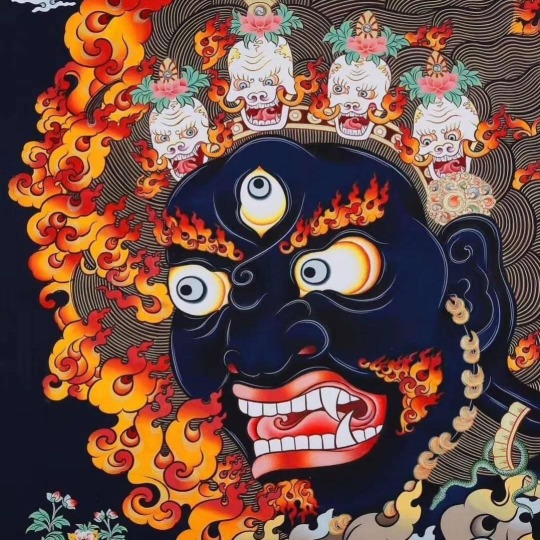
Mahakala (Sanskrit: Mahākāla) is a Dharmapala ("protector of Dharma") in Vajrayana Buddhism (Tibetan, Nepalese Newar, Chinese, Japanese Shingon traditions and related). In Chinese and Japanese Buddhism tradition is known as Daheitian or Daikokuten (大黒天).
Mahakala is a category of Tantric Buddhist deity. His primary function is as a protector (Dharmapala) and specifically the primary Wisdom Protector of Tantric Buddhism - Vajrayana. There are dozens of different variations and forms of Mahakala. He is typically in wrathful appearance following the Indian model of a Raksha demon. In most occurrences and uses of Mahakala, he is paired with a meditational deity such as Panjarnata Mahakala and Shri Hevajra, Chaturbhuja Mahakala and Chakrasamvara, Chaturmukha Mahakala and Guhyasamaja. In most cases Mahakala is an emanation, or wrathful aspect, of the principal meditational deity that he is associated with. For instance Panjarnata Mahakala is the most wrathful emanation, or form, of Hevajra. In other situations Mahakala might be a wrathful emanation of Vajradhara or Akshobhya Buddha. Aside from the individual Anuttarayoga Tantras that teach various forms of Mahakala, the principal texts are the Twenty-five and Fifty Chapter Mahakala Tantra.
In one specific case, Shadbhuja Mahakala, Avalokiteshvara takes on the form of Mahakala. Therefore, it can be said that the Shadbhuja form, with one face and six hands, arising from the Eight Chapter Mahakala Tantra, is a wrathful Avalokiteshvara.
http://en.wikipedia.org/wiki/Mahakala
49 notes
·
View notes
Text
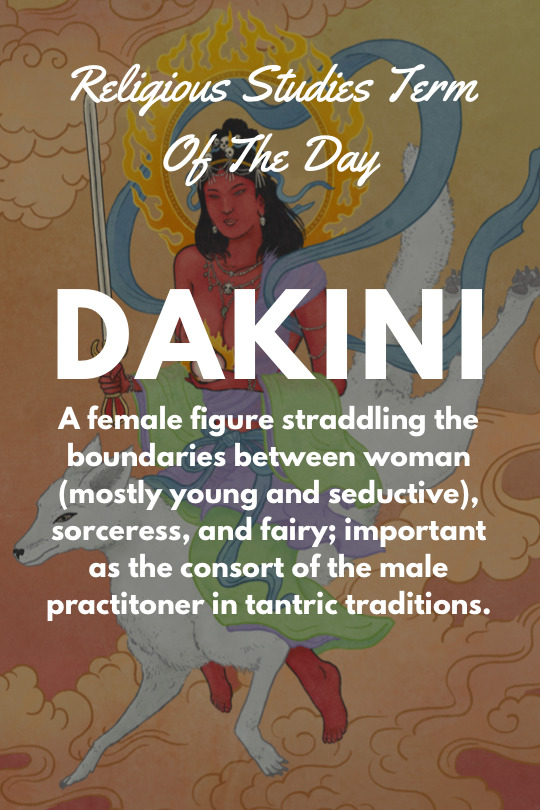
Religious Studies Term Of The Day: Dakini
Hey everyone! Now that the Christmas season is over, it’s back to Buddhism! Today I wanted to talk about a concept that I don’t think is super well known about in Buddhism: the Dakini. Dakini are complex creatures to talk about, but they are a sort of supernatural term that is pretty close to the English idea of a witch, or maybe even a fairy in some sense. They aren’t like a widespread Buddhist idea, but only find themselves in tantric traditions like the Vajrayana Buddhists. In these traditions, sex, whether it be literal or metaphorical, is a pathway to enlightenment, and it requires male and female sexual energy to accomplish that. I’m not an expert so please correct me if I am wrong, but my readings on the subject seem to imply that the Dakini is the source of the female sexual energy needed for the rituals, that she, whether she is a low class woman brought in for the job or an actual supernatural creature summoned for the task.
This term is super vague and flexible, so I have a hard time pinning it down, but a great example of a dakin would be Ma-gcig Lab-sgron, a figure of Tantric Buddhism born in 1055. She is complicated to pin down, as she is a real figure, but also a supernatural one, a person who has many titles and attributes that would take a while to look into, but she might be a good starting place for anyone curious about what a dakini means. But for now, that’s all I have to share. I hope you’re all safe and have a wonderful day.
#religiousstudies#religious studies#religion#religiousliteracy#religions#women and religious traditions#leona m anderson#pamela dicky young#Eva k neumaier#oxford#buddhist#buddhism#tantric buddhism#vajrayana buddhism#tibetan buddhism#dakini#woman#sorceress#fairy girl#tantric#factsdaily#fun facts#factoftheday
6 notes
·
View notes
Text
i include some of the tantric buddhist techniques with my work now but always keep it very open with Vama marga and white tigress teachings these days because let's be real, in duality even the best sacred teachings feared the woman
3 notes
·
View notes
Text
Reflections on Samaya and Advice from Tulku Urgyen Rinpoche
The worst obstacle for a practitioner is when crowds of followers begin to gather and say, “You are so wonderful, you are such a great practitioner, you are very special. Please give us teachings. Please guide us.”
Starting to have a great following causes the most difficult kind of obstacle because unless one is the foremost type of practitioner, one will think, “Hey, maybe I am special. Maybe…

View On WordPress
0 notes
Text

Those who seek happiness in pleasure, wealth, glory, power, and heroics are as naive as the child who tries to catch a rainbow and wear it as a coat.
~ Dilgo Khyentse Rinpoche
#Dilgo Khyentse Rinpoche#Padmasambhava#Guru Rinpoche#buddha#buddhist#buddhism#dharma#sangha#mahayana#zen#milarepa#tibetan buddhism#thich nhat hanh#four noble truths#manjushri#amitaba buddha#avalokitesvara#green tara#tantric#vajrasattva#vajrapani#rainbow body#bodhisattva#buddha samantabhadra
40 notes
·
View notes
Photo
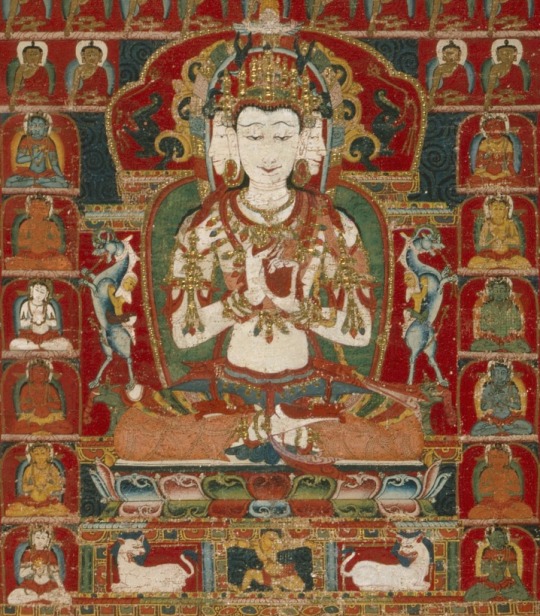
Vairocana is a celestial or cosmic Buddha, or sometimes interpreted as a primordial Buddha, or later as the Dharmakāya of the Guatama Buddha. Dharmakāya is one of the three bodies (trikāya) of a buddha in Mahāyāna Buddhism. The dharmakāya constitutes the unmanifested, "inconceivable" (acintya) aspect of a buddha out of which buddhas arise and to which they return after their dissolution.
A sutra ‘Vairocana’s Awakening Sutra’ is an early Tantric manual. It begins in the celestial palace symbolizing all existence with the Vairocana Buddha conversing with a disciple.
read an English translation here
https://www.bdk.or.jp/document/dgtl-dl/dBET_T0848_Vairocana_2005.pdf
#sutra#buddhism#vairocana#tantra#tantric#scripture#sanskrit#tibetan#art#artwork#meditation#enlightenment#yoga
46 notes
·
View notes
Text
buddhist, but also, indus realm?
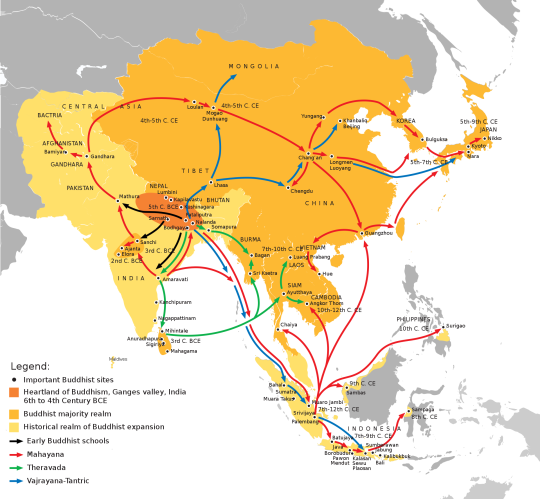
Central Asia and not ALL of East Asia but the western parts?
some interesting points on this
buddhist originally spread within west and south (in "india") - not eastwards and out
Mahayana developed outside Magadhi and travelled back
Thevarada did not spread west/north
Vajrayana did not go south or west
Buddhism went to Vietnam from China
Chang'an was a hotspot in China
Beijing, Mongolia & Tibet received Vajrayana-Tantric, only
Sri Lanka & Burma - only Buddhist countries in SA today both only received Thevarada
North China + East Asia originally received Mahayana Buddhism in the north only through Greek-influenced Central Asia and Vajrayana Tantric via Tibet
connection between Magadhi & Bhils ... & Sri Lanka ultimately
#buddhism#mahayana#tantric#hindu#hinduism#buddhist#buddha#asia#south asia#south east asia#east asia#central asia
4 notes
·
View notes
Text

“There is no miserable place waiting for you, no hell realm, sitting and waiting like Alaska—waiting to turn you into ice cream.”
I don’t Lama Yeshe. Deep in the dirty south lies a place called Texas. Here in Garland- of Zombieland fame- where the insulation is thin and power grids fail our PTSD gets triggered quick by Jack Frost. My poor little heater is in there damn near trying to kill itself to keep the house a crisp 59 degrees.
Now, as a Detroit native who knows all too well how to layer clothes and stay warm I have no fear of being a popsicle. Some snow would be nice but I can see this being someone’s personal hell. 😂😂😂
Which leads us to the last part of the quote:
“But whatever you call it—hell or the suffering realms—it is something that you enter by creating a world of neurotic fantasy and believing it to be real. It sounds simple, but that's exactly what happens.”
I’m sure I’ve shared this before but I pull Becoming Vajrasattva off the shelf every time the temp in Texas dips below 20 degrees. A) it’s a great book. B) Thubten Yeshe loved to laugh. C) Laughter triggers endorphins and endorphins help us remember so I know this book know it.
Now, if some comic could just do a calculus stand up routine…
#Thubten Yeshe#quotes#becoming vajrasattva#tibetan buddhism#tantric#funny quotes#inner transformation#mysticism#wisdom#hell realms#Texas got winter ptsd#spirituality#philosophy#remind me to get insulation blown in this spring
2 notes
·
View notes
Text

Religious Studies Term Of The Day: Tantra
#religiousstudies#religious studies#religion#religiousliteracy#religiouswritings#women and religious traditions#leona m anderson#oxford#pamela dicky young#Eva k neumaier#vajrayana buddhism#tantric buddhism#buddhist wisdom#buddhist teachings#buddhist#buddhism#tantra#tibetan buddhism#vajrayana#buddha#fun facts#factsdaily#factoftheday#random facts
1 note
·
View note
Text
You know there was a ritual practice in Indian alchemy where you gathered menstrual blood in a human skull and drank from it and they were onto something I think
1 note
·
View note
Text
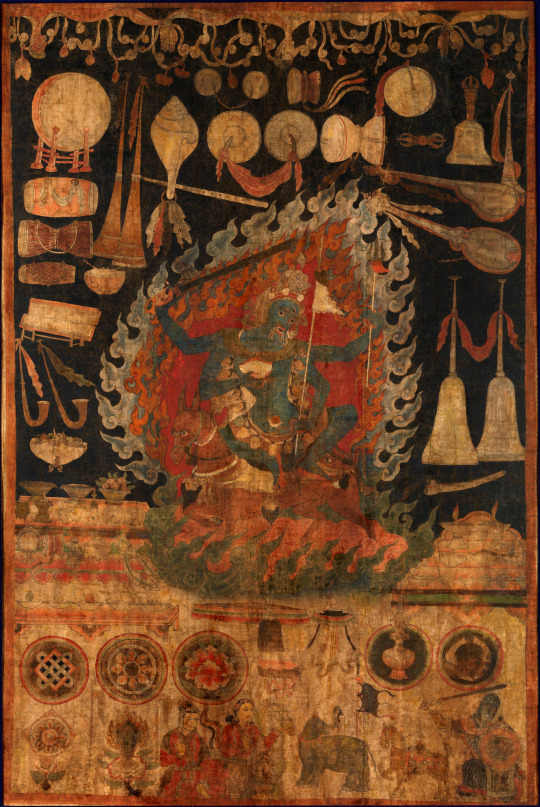
offerings to the Goddess Palden Lhamo
1 note
·
View note
Text
Tantra: Tilopa’s Song of Mahamudra
Explore the profound world of Tantra and the teachings of Tilopa, an Indian Buddhist monk in the tantric Kagyu lineage of Tibetan Buddhism. Delve into the essence of Mahamudra, a set of spiritual practices that accelerate the path to Buddhahood.
Tantra
The Supreme Understanding
Tantra:
The Supreme Understanding
Introduction
Tilopa’s Song of Mahamudra
A deep and insightful look into the underlying ideas of Tantra.
Walking the road to enlightenment by embodying the full acceptance of all that is. A commentary on Tilopa’s marvelous song.
Tilopa,
was an Indian Buddhist monk in the tantric Kagyu lineage of Tibetan Buddhism.
He…

View On WordPress
#6 Yogas of Naropa#Anuttarayoga Tantra#Buddhahood#Buddhist masters#Compassion#Divine Feminine#Essence of teachings#Ganges river#Guru yoga#Kagyu lineage#Mahamudra#Mahamudra Song#Marpa Lotsawa#Naropa#Primordial Buddha#Supreme Understanding#Tantra#tantric buddhist#Tibet#tibetan buddhism#tilopa#Vajradhara#Wisdom#Yogi Milarepa
1 note
·
View note
Text
youtube
Sneak Peek | When Stones Move: Journeys of the Tamil Yoginis, June 8, 2023
What happens to stone sculptures in India when they are separated from their original context? Follow the multiple journeys of a group of goddesses called yoginis from their temple, which no longer exists, to a bustling South Indian city and onward to museum collections on three continents. In this richly illustrated talk, Emma Natalya Stein, assistant curator of South Asian and Southeast Asian art, will reveal a recently discovered yogini—not in a museum but in a local Tamil shrine—and give a sneak peek into plans for an exhibition that seeks to reunite this important group of goddesses.
This talk is part of the monthly lunchtime series Sneak Peek: New Research from the National Museum of Asian Art, where staff members present brief, personal perspectives and ongoing research, followed by discussion. This year, the series focuses on the theme of journeys—those that works of art depict and those they have undergone—in the collections of the National Museum of Asian Art.
Emma Natalya Stein (PhD, Yale) joined the National Museum of Asian Art’s curatorial staff in 2019. Her exhibitions include Revealing Krishna: Journey to Cambodia’s Sacred Mountain, Prehistoric Spirals: Earthenware from Thailand, Power in Southeast Asia, and The Art of Knowing in South Asia, Southeast Asia, and the Himalayas. Emma has published articles on topics including yoginis, temple networks, and water’s edge urbanism, and her monograph, Constructing Kanchi: City of Infinite Temples, was featured on the New Books in Indian Religions podcast (May 2022). Emma’s research is grounded in fieldwork in South Asia and Southeast Asia, where she documents and maps monuments in diverse landscapes.
National Museum of Asian Art, Smithsonian
Yogini, late 9th--mid-10th century
From a now-destroyed Yogini temple, Kaveripakkam, Tamil Nadu, India [1]
Stone (metagabbro)
H x W x D: 116 x 76 x 43.2 cm (45 11/16 x 29 15/16 x 17 in)
Goddess seated cross-legged carved in high relief on a rounded granite slab. Goose vahana carved in light relief on base. She holds a winnower (a basketlike apparatus for separating chaff from grain), a small broom, and a skull cup in three hands, and her forth hand touches her breast in a pose signifying self-absorbtion. She wears a tall crown, one crocodilian and one cobra earring, and her hair is loose behind her head.
Provenance:
By 1925-1927: N. Tangavelou Pillai and Gabriel Jouveau-Dubreuil (1885-1945) reportedly discovered in Kanchi (also known as Kanchipuram or Kancheepuram), Tamil Nadu, India [2]
1927-about 1950: C.T. Loo & Company, New York, NY and Paris, France purchased from Gabriel Jouveau-Dubreuil [3]
About 1950-?: Christian Humann (1929-1981), New York, NY purchased from C.T. Loo & Company, NY [4]
By 1968-1974: Drs. Arthur M., Raymond, and Mortimer Sackler, New York, NY purchased from Christian Humann [5]
1974-1982: Dr. Arthur M. Sackler, New York, NY purchased from Drs. Raymond and Mortimer Sackler in 1974 [6]
From 1987: Arthur M. Sackler Gallery, gift of Arthur M. Sackler on September 11, 1987 [7]
Notes:
[1] The Yogini temple, which originally contained at least 14 sculptures, fell out of use sometime in the following centuries. Likely constructed of stone foundations supporting brick walls, no trace of its structure has been identified. See Padma Kaimal, "Scattered goddesses Travels with the Yoginis" [book] (Ann Arbor: Association for Asian Studies, Inc., 2012) and Emma Natalya Stein and Katherine E. Kasdorf, "Alternate Narratives for the Tamil Yoginis: Reconsidering the 'Kanchi Yoginis' Past, Present, and Future" in Religions, vol. 13 (September 2022).
[2] Gabriel Jouveau-Dubreuil was a French-born archeologist who lived in Pondicherry, India. He worked with several Indian agents to source antiquities to export for sale in Europe. N. Tangavelou Pillai, who worked around Kanchi, was Jouveau-Dubreuil's primary agent for Hindu antiquities. Reportedly Jouveau-Dubreuil and Tangavelou discovered this sculpture along with others similar sculptures during a trip to Kanchi in August 1925. Tangavelou collected sixty signatures from individuals who consented to the removal of the sculptures. Despite ongoing objections, Tangavelou believed the majority approved of the removal and sent the sculptures to Pondicherry for export. See Kaimal, p. 33-137 and Stein and Kasdorf, 17.
[3] The dealer C. T. Loo and Jouveau-Dubreuil became acquainted in Paris between 1922 and 1923. Loo proposed that Jouveau-Dubreuil become Loo's scout, supplier, and buying agent in India. It is likely that Loo was not Jouveau-Dubreuil's only patron, see Kaimal, p. 137 and p. 243, note 25. Jouveau-Dubreuil and Tangavelou photographed each recovered sculpture before Jouveau-Dubreuil exported them to France; these photographs are preserved at the Musée Guimet, Paris and in the archives of the Red Pagoda, Paris. See Kaimal, p. 33-137.
Jouveau-Dubreuil and C.T. Loo collaborated closely on the export of the sculptures. The sculptures arrived in Paris via several shipments, the first arriving in the fall of 1926 and the last by July 1927. The correspondence between Loo and Jouveau-Dubreuil suggests this yogini was part of a shipment in January 1926. See Emma Natalya Stein and Katherine E. Kasdorf, "Tracking the Tamil Yoginis: New Findings from the Jouveau-Dubreuil Archives" presentation during webinar "Translocation of South Asian Art: Provenance and Documentation," October 7, 2022, power point in object file. See also Kaimal's diagram of the sculptures mentioned in Loo and Jouveau-Dubreuil's correspondence, p. 137.
[4] See Kaimal, p.164.
[5] See documentation from the Brooklyn Museum cited by Kaimal, p. 255. The Collection and Collections Information Department at the Brooklyn Museum reports that they received the object on loan in 1968 and credited the three Sackler brothers (Drs. Arthur M, Raymond, and Mortimer Sackler) with ownership. Arthur M. Sackler's office notified the Collection and Collections Information Department at the Brooklyn Museum of his exclusive ownership in December 1974.
[6] The 1982 inventory of Arthur M. Sackler's gift to the Arthur M. Sackler Gallery reports Arthur M. Sackler as the owner, see 1982 inventory, copy in file.
[7] Pursuant to the agreement between Arthur M. Sackler and the Smithsonian Institution dated July 28, 1982, legal title of the donated objects was transferred to the Arthur M. Sackler Gallery on September 11, 1987.
Research updated on February 3, 2023.
Collection of the National Museum of Asian Art, Smithsonian
#National Museum of Asian Art#Smithsonian#Emma Natalya Stein#art#sculpture#Tamil Nadu#Indian#figure#repurpose#religion#hinduism#buddhism#stone#yogini#Shaktism#10th century#esoteric#chola dynasty#9th century#tantric#12th century#Kaveripakkam#Vajrayani#Kanchi#colonialism#matrika#Youtube
0 notes
